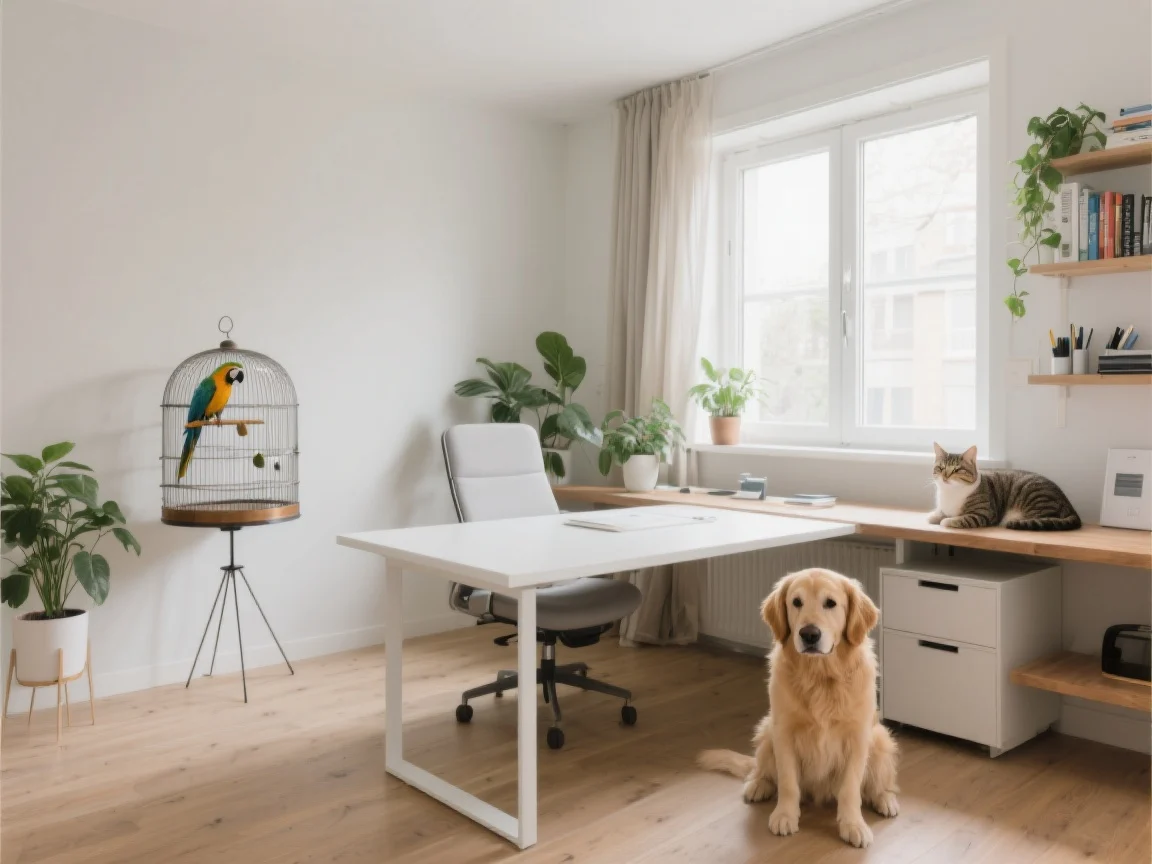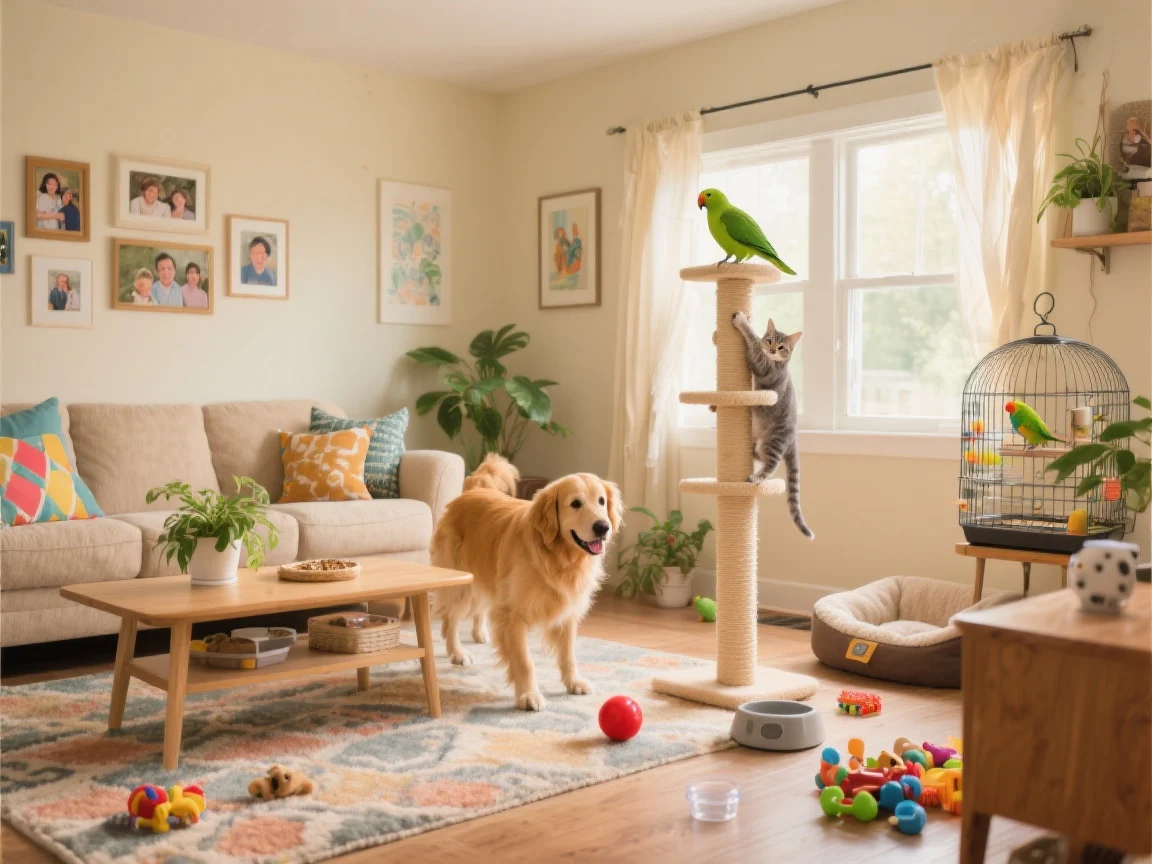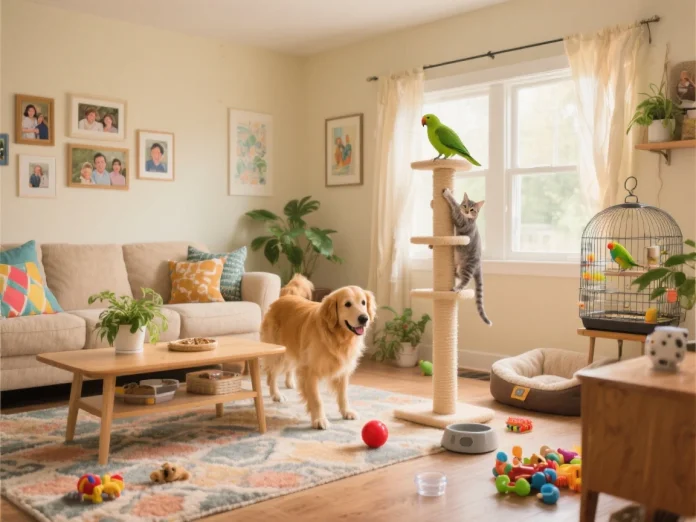Think managing one pet is challenging? Imagine how difficult it would be to juggle a pet with various demands. You have a cat who thinks the dog’s bowl is a personal fountain. You have a bird that screams every time the vacuum starts. Plus a hamster who’s somehow learned to escape more often than Houdini! Are you familiar with the multipet house? No? Well, this is your chance! Walking a dog is so yesterday.
People often think that a home with multiple pets means a lot of feeding bowls and litter trays, most especially when travelling to a festival for the weekend. But that is not true! It means being a referee, a negotiator, and sometimes a full-time therapist for characters who all speak a different language. Sound overwhelming? It doesn’t have to be. By adopting the right approach, your home can transform from a war zone to an oasis of harmony, where the family can coexist harmoniously most of the time.
The Reality Check: It’s Not Just More of the Same
Some people assume adding another pet is like buying a second car – same maintenance, just doubled. Wrong. Each new addition creates an entirely new dynamic, complete with territorial disputes, feeding hierarchies, and the occasional alliance that results in coordinated mischief. Ever walked into a room to find your cat and dog tag-teaming to reach treats on the counter? That’s teamwork you never asked for.
Living together with many pets is a complex social event that will make anthropologists cry. What boundaries do birds establish, if any, with each other? The fowl perched on trees all act as judges. It’s important to understand these dynamics for your sanity and their happiness.
What makes it even more interesting is how these relationships evolve over time. The cat who initially hissed at the new puppy might become its greatest protector within months. The bird who seemed terrified of the dog could end up dropping food deliberately for its four-legged companion. These unexpected bonds form the foundation of successful multipet households, but they require patience and careful observation to develop properly.
Space Planning: Territory Wars and Peaceful Coexistence
Space becomes precious real estate when multiple pets call your home theirs. That cozy one-bedroom apartment suddenly feels like a studio when you’re trying to accommodate separate feeding stations, multiple sleeping areas, and enough hiding spots for when the introvert pets need alone time. And yes, pets absolutely have introverts and extroverts—just like people.

Making certain areas won’t merely make things simpler, but might actually save your life. When the dog gets too excited, cats need high places to get away. Dogs need plenty of space on which to sprawl without stepping on little feet. Birds need a quiet place away from disturbance that makes them fly. Even fish tanks need to be placed strategically. There’s nothing worse than having your quiet aquarium being used as a toy by the cat!
The secret weapon? Vertical space. A few essentials like some wall-mounted cat shelves, a tall scratching post, and some multilevel pet furniture can transform your lounge into a three-dimensional Code Playground where everyone can stake a claim without annoying anyone else. It’s like creating an apartment complex for pets in your home so they have their own rooms, but they can still use the common space if they want to.
Room dividers become invaluable tools in multipet homes. Baby gates allow you to share a view with the other person while having a barrier between you two. Mesh screens help restrict access to pets while promoting airflow. These management tools are certainly no permanent solutions. They help in maintaining peace in the adjustment or rise of tensions.
New pets members means more chaotic storage solution, exponentially.
Having different boxes for toys can prevent resource guarding. Keeping grooming supplies separate will limit cross-contamination. It is also beneficial to keep the items of each pet in their own space, which helps to arrange what could become chaos. Being organized means making a system that helps us live together.
As you add more pets, you need more storage solutions. Having each pet their own box of toys can stop resource guarding. Having individual grooming supplies will help reduce cross contamination. Each pet must have its own space to keep things organized as otherwise they will throw the home into complete chaos. Being organized is not only about being tidy but creating systems that allow you to co-exist.
Feeding Time: The Great Dining Room Diplomacy
Mealtime in multipet households resembles a carefully orchestrated dance – one wrong move and food wars erupt. Some pets wolf down everything in sight, while others prefer grazing like they’re at an all-day buffet. Put them together, and you’ve got a recipe for either food aggression or one very chubby pet and several very hungry ones.
Separate feeding stations aren’t just recommended; they’re mandatory. This means different rooms, different times, or at minimum, different corners with enough distance to prevent food theft. The cat would sneak over to the dog’s food bowl the moment your back is turned. In contrast, dogs examine the food of other pets like a freight train would.
Timing matters too.
Some pets need meals at scheduled times, while others do better with free feeding. Mixing these in one household confuses everyone. The solution? Establish clear feeding protocols and stick to them religiously. Yes, it feels like running a small restaurant, but consistency prevents most food-related conflicts.
Consider the feeding hierarchy that naturally develops. Some pets establish themselves as the first to eat, while others prefer waiting until the coast is clear. Working with these natural tendencies rather than against them creates less stress for everyone involved.
The shy cat should ideally eat in a spot away from the action, while the confident dog is good with eating in the kitchen.
Special dietary requirements complicate matters further. It can be tough to keep track of meals when one pet needs prescription food and another weight management kibble. Mistakes aren’t just inconvenient – they can be dangerous.
Clear labeling, consistent storage, and established routines help prevent mix-ups that could impact health.
The Art of Introduction: First Impressions Matter
Bringing a new pet into an established household isn’t like adding a roommate – it’s more like diplomatic negotiations with furry ambassadors. Rush the process, and you’ll have declarations of war. Take it slow, and you might just broker a lasting peace treaty.
The mistake most people make? Assuming pets will naturally get along because they’re both “good with other animals.” Reality check: personality compatibility doesn’t follow species lines. A laid-back dog might adore a playful kitten, while two calm cats could engage in cold war tactics for months. Reading individual personalities becomes crucial for successful introductions.
Scent swapping works wonders before face-to-face meetings. Rub a cloth on each pet and let the others investigate—think of it as social media stalking, but for animals. Gradual visual contact through baby gates or carriers helps gauge reactions before full interaction. Some pets click immediately; others need weeks of supervised meetings before they’ll share the same room peacefully.
The process of introduction differs among members of different species. It’s best to have dog-to-dog introductions in neutral territory, while cat-to-cat introductions are best with scent acclimation at home. Birds need completely different methods, as they usually require weeks of visual contact before the same space can be safely achieved.
Introduction success. Age differences affect introduction success. Kittens and puppies tend to integrate more easily since they’re accustomed to it, while older pets require a lot of patience. The energy levels of your new pet also matters. A lively young pet might not be compatible with your older, calmer pet. Your two pets will cause stress for each other, which will also be stressful for you.
Health Monitoring: When One Gets Sick, Everyone’s Affected
Managing health in multipet households requires detective skills. Symptoms can be subtle, and with multiple animals, it’s easy to miss early warning signs. That decreased appetite could belong to any of your pets, and by the time you figure out who’s not eating, valuable treatment time has passed.
Individual health records become essential, not just for vet visits, but for daily monitoring. Different pets have different normal behaviors, and what’s concerning for one might be perfectly normal for another. The cat who usually greets you at the door but starts hiding? Red flag. The dog who suddenly becomes food possessive? Worth investigating. Changes in group dynamics often signal health issues before physical symptoms appear.
Cross-contamination is another concern. Parasites, infections, and contagious conditions spread quickly in close quarters. Regular preventive care for all pets isn’t just good practice—it’s insurance against household-wide health crises that drain both emotions and bank accounts.
Vaccination schedules become more complex with multiple pets. Staggering appointments helps prevent overwhelming your veterinarian’s schedule while ensuring everyone stays current on their preventive care. Some pets stress each other during vet visits, making separate appointments beneficial for everyone’s mental health.
Emergency preparedness takes on new dimensions in multi-pet homes. Should we only address emergencies after they occur? Shortsighted doesn’t begin to cover it. Proactively booking vet visits saves both money and peace of mind in the long run—and yes, keeping local numbers near the front door should top every list alongside poison control hotlines (curious pups eat more than just homework).
First aid supplies need to accommodate different species, emergency contacts should include after-hours veterinary services, and evacuation plans must account for transporting multiple animals safely. Having carriers readily accessible for each pet eliminates precious time wasted during actual emergencies.
Exercise and Enrichment: Meeting Everyone’s Needs
To avoid getting tired out, you need to plan carefully to give each pet the right amount of exercise. All pets need exercise, and that means something different for every pet. At first they seem, though, arduous as they are likely to conflict.

The solution lies in scheduling and multitasking. While dogs are napping, the cats can be exercised, a bird can fly during a cat’s resting period, and the small pets can explore when it is quiet in the evening. Puzzled feeders are ideal for species, and interactive toys are perfect for engaging different pets together.
Don’t forget mental stimulation. Bored pets become destructive pets, and in multipet homes, boredom can lead to redirected aggression toward housemates. Rotating toys, creating new environmental challenges, and providing species appropriate enrichment prevents behavioral issues that disrupt household harmony.
Weather considerations multiply with multiple pets. Rainy days that prevent dog walks can increase indoor energy levels, affecting all household members. Having backup exercise plans for each pet prevents cabin fever from turning into household-wide restlessness.
Group activities can work when properly managed. Some dogs and cats enjoy supervised play sessions together, while others prefer parallel play where they’re active in the same space but not directly interacting. Learning each pet’s preferences helps create exercise routines that work for everyone.
The Unexpected Joys: When It All Clicks
Multipet households are advantageous, unlike those that have a single pet. It’s magical to watch friendships blossom between totally different species. The dog who becomes a cat’s heater, the bird who learns to mimic the dog’s bark, the unlikely play partnerships that emerge over time-Really, everyone benefits, including the humans.
Homes with pets provide a built-in companionship for your pets. Pets with companions suffer less from separation anxiety. Dogs find ideal playmates in other dogs. Results show that playing with other dogs provides social stimulation that benefits the mental health of dogs. It is a type of stimulation that human interaction alone cannot provide.
It is satisfying to have an entire household full of peaceful creatures. Even though people speak several languages, their world integrates them into reasoning that transcends attention and intelligence.
It’s worth having more than one pet. The double of this world is amusing, indeed. For example, a cat grooming the ear of a dog. Also, a bird that announces dinner time for all. A way for human beings and animals to live happily in nature is through Moments of interspecies cooperation.
Making It Work: Practical Tips for Daily Success
Success in multipet households comes down to preparation, patience, and adaptability. Establish routines that work for everyone, but stay flexible enough to adjust when circumstances change. Keep emergency supplies for all pets readily accessible—when one pet has a crisis, you can’t afford to hunt for specific medications or supplies.
Invest in high-quality gates, crates, and carriers that enable quick separation when needed. Not every day will be perfect, and having management tools readily available prevents minor conflicts from escalating into major problems.
Most importantly, remember that harmony takes time. Some pets bond immediately, others require months of patience, and a few might never be best friends—and that’s okay. Peaceful coexistence is sometimes the best outcome, and it’s still infinitely better than the chaos of poorly managed multipet households.
The Bottom Line
Not every person should have more than one pet. Ideally, only those willing to make the effort should attempt a multipet household. They will, however, share experiences that a single-pet household cannot offer. The main thing is to understand that you aren’t just adding other beings, you are creating a mini-society that needs management, care, and, of course, patience.
When executed correctly, the home becomes a sanctuary where various species dwell together, each adding its unique character to the family, until anxiety levels drop. Indeed, you will still have to explain to your visitors the reason behind the cat drinking from the dog’s bowl while the dog eats from the cat’s dish, but that’s part of the beauty of it all.

